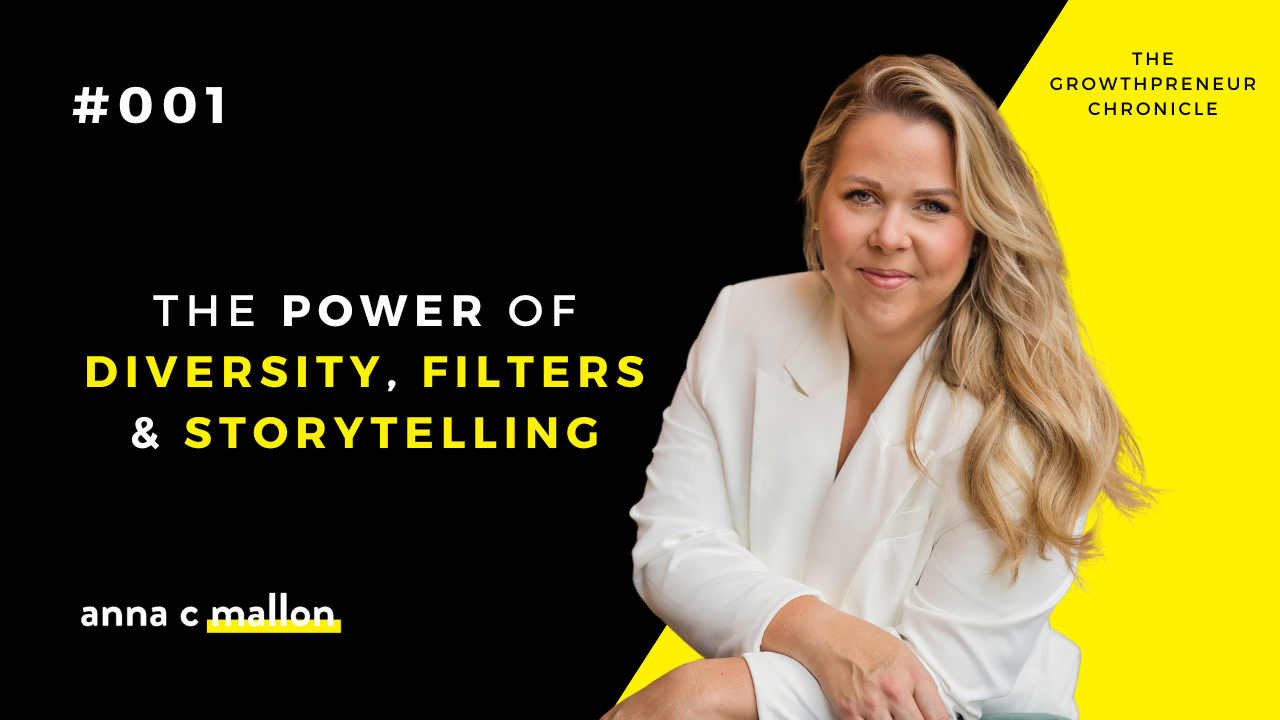
GC#001: The Power of Diversity, Filters & Storytelling
Feb 03, 2023Reading time: 5 minutes 21 seconds
Prefer hearing this newsletter? Have it read to you down here.
Welcome to the Growthpreneur Chronicle - a monthly letter dedicated to supporting ambitious tech professionals, founders, and career changers looking for help or to accelerate growth/change goals.
In this monthly newsletter, I promise to stay under 6 minutes of your time and support your growth goals (in business, venture, and in life) through access to proven tools, networks, and methods.
Overview & Takeaways:
- Diversity And Inclusivity Culture Is The Breeding Ground For Innovation
- Filters Like Communication Styles, Action Direction, Task Scope, Change, Influence, And Convincer Inputs Create Unicorn Teams
- Storytelling Is Essential to Venture Funding, Sales, and Team Leadership
- Cortisol Levels versus Business Success
Section 1: Scaling For Success
Hiring
Hiring is a real pain point in the startup world, especially in the early stages. That’s why my colleague Chris and I put together a hiring workshop for the last Startupbootcamp and Techstars cohorts that we mentored.
We got a ton of questions about hiring and wanted to share our experience and knowledge to help out. I’ve been a people manager for over 20 years, and Chris is a former CTO, so between the two of us, we’ve got a lot of experience to share!
While Chris talked about the latest trends in application development, cloud strategy, and building serverless, I shared my tips for hiring, as well as how diversity and inclusivity culture is the breeding ground for innovation.
We also discussed how to craft a VP specifically for startup roles and shared some insights on how companies like Amazon approach hiring.
“The 5 Hiring Mistakes That You Really Don’t Want To Make” (Read More)
- Not hiring for startup culture (look for the best attitude and motivation, and not the best skills)
- Not being aware of our own biases/filters -> hiring who we like/people like us - watch out also for job posting & interview questions
- Interviewer panels not reflecting diversity - critical for perspectives (internal) AND to communicate D&I to the applicant
- Not leveraging video/automation to reduce time and effort for application and screening
Co-Founder Communication
As a people manager, I enjoy getting feedback from hyper-growth-focused entrepreneurs, as well as innovation leaders in the business and tech space. I recently had the privilege of hosting a session with 55 brilliant founders at the very beginning of the new Antler program in Amsterdam.
These founders represented 20 different nationalities, had an average of over 10 years of work experience and were experts in fields such as Space Tech, AI, ML, Renewable Energy, B2B Sales, Finance, Fashion and Crypto.
During the session, I got to talk to these amazing people about what I am most passionate about; Co-Founder Chemistry and Unicorn Teams!
Some Of These Insights To Consider include 👇 (Read more)
- Communication Styles: Affective / Neutral: how emotional - or - literal is your communication? And how can you adjust this to your co-founder (if different)?
- Action Direction: Goal / Problem orientation: if your co-founder is problem oriented but you’re pitching him or her a goal, then you might not connect deeply. Switch your pitch.
- Task Scope: Breadth / Depth: are you a big-picture person or a detail person? How about dedicating meetings and discussions accordingly to ensure no disconnect occurs here?
- Change: Same / Evolution / Difference: which one are you motivated for and which one is your co-founder? Can you tweak your communication accordingly, and place yourselves in the best fit?
- Influence: Power / Affiliation / Achievement: how do you influence and does this work on the other one?
- Convincer Inputs: Seeing / Hearing / Reading / Doing: this one’s a big one. Even when you pitch to investors or customers - make sure you know yours and be sure to cover all if you do not know your audience.
Predicting Startup Success
During my chat with Michelle Duval, CEO of Fingerprint for Success (F4S), we talked about how to predict the success of your startup based on the people you bring in, some of the biggest mistakes that founders make, and why personal development is key to your startup’s longevity. Michelle is a real expert in this field and we covered a lot of ground in this conversation.
And if you’re wondering whether your startup is prepared, check it out. 👇 (Read More);
- In F4S’s research, their datasets showed that successful early-stage ventures, particularly those in deep tech, have a very low bias/preference for advanced planning - meaning, planning before conducting any experimentation;
- Lower the structure & planning, and experiment more in order to reduce early venture failure-rate
- Move quickly; validate findings before investing in structure
- Founders should use their voices to tell a story about that venture; this story should inspire and captivate their teams, as well as attract team members who will align with the venture’s goals and vision.
- This type of storytelling will also enable founders to receive the type of funding that they would need in order to continue their journey
- As new team members are onboarded, beware of the fact that your venture’s team needs will constantly change;
- Instead of only hiring skill and qualification, make hires based on attitude and motivation, because these are the most transferrable assets in your venture
- Big-picture thinking correlates with greater ambition and F4S found that this particular type of thinking also leads to more rounds of capital - these team members do not need a lot of detail in order to understand things quickly.
- A technical founder will still need an entrepreneurial (big picture) mindset, in order to continuously experiment.
- Most successful startups are rotating team members every 3 to 6 months, so if you have a team that has the right attitude and motivation — that becomes their X-factor. They’re able to then transfer this X-factor to their next role.
- Focus on the duality of goal orientation as well as problem-solving
- Get a co-founder who is able to balance your deficiencies, i.e. if you are more of the problem solver, then partner up with someone who has a big-picture vision.
If you’re interested in learning more, you can check out the full video and table of contents that we put together here.

Section 2: Changepreneurship
Storytelling
As an innovation mentor specializing in storytelling for venture funding and sales, over the past decade, I recently worked with the new YES!Delft cohort and reminded them that storytelling is a powerful method for connecting with your audience emotionally, and making them feel your point of view. This same technique can be applied to fundraising, sales, and leadership.
Here are 6 things to MUST do to become a better storyteller and stand out in the crowded business landscape (Read More)
Step 1: Add a Setup, Struggle (Problem), and Resolution (Solution)
Setup When it comes to storytelling for investment, sales, or leadership, it's crucial to set the stage by providing context for your audience. This includes outlining the current state of the industry or market, as well as introducing the key players involved in the story.
Struggle (Problem) Next, it's important to identify a specific problem or challenge that your audience can relate to. This will help build tension and create a sense of urgency, making it more likely that your audience will engage with your story.
Resolution (Solution) Once you've established the problem, it's time to provide a solution. This could be a new product, service, or strategy that your company is offering to solve the problem. It's important to clearly communicate how your solution will benefit your audience and address their pain points.
Step 2: Pick the right problem and build tension
It's important to pick a problem that your audience is currently facing or will face in the future. It's also important to build tension by highlighting the consequences of not solving the problem.
Step 3: Invest in rich characters
Investors make big bets on the team, so it's important to focus on the team's experience and qualifications. Make sure to highlight the team members who have the most relevant experience and the most impressive qualifications.
Step 4: Add (few) memorable details, make it repeatable
People remember stories better when they have vivid details. Make sure to include a few memorable details that will make your story stand out. Also, make sure that the story is repeatable so that your audience can remember it and share it with others.
Step 5: Think delivery
Investors have seen thousands of pitches, so engagement is key. Use humor, anecdotes, and other storytelling techniques to keep your audience engaged.
Step 6: Tailor the content to your audience
A sales deck or pitch is not a pitch deck. Make sure to tailor the content of your story to your specific audience. This means understanding their pain points, their goals, and what they are looking for in a solution.
Section 3: Productivity & Health
The Truth About Cortisol: How Stress Affects Your Business
On the first episode of the Healthy Hypergrowth Vodcast, I spoke to Wesley Delbarae from Omnia about the link between personal health and business success.
He found that lot of early-stage founders underestimate the importance of these three basic fundamentals, choosing to rely on stimulants such as caffeine and nicotine, but the body keeps tabs, and eventually, you will pay the price — with your health.
💡 DID YOU KNOW: Where you store fat on your body correlates with your hormonal balance, and blood sugar levels?
- Oblique fat is closely related to blood-sugar management: If you find yourself gaining weight in this particular area, you might want to consider
- Eating cleaner (more whole and unprocessed) carbohydrates
- Drinking enough water
- Staying away from refined sugars
- Eating a well-balanced diet
What about stress? 💡 DID YOU KNOW: Chronically high cortisol (the stress hormone) levels will result in your gaining abdominal (belly) fat - BUT while cortisol has a bad rap, it’s actually not an evil hormone.
In business, you need cortisol levels to be high early in the day, so that you can be alert, make better decisions, and assimilate new information; and then you want your cortisol levels to be low in the evening so that you can get a restful night’s sleep.
Without proper cortisol management, you can forget about maintaining optimal health and productivity. (Read More)

Voilà
I hope you found value in this inaugural edition of The Growthpreneur Chronicle. 🙏
If you have any questions about anything in this email, just reply. It goes straight to my inbox and I’d love to hear from you.
To stay on the pulse of these topics, and everything else that relates to your business, leadership and productivity, then join me on LinkedIn and press on that bell icon 🔔 , so you never miss a post from me.
Warmly, Anna C Mallon
Whenever you're ready, there are two further ways I can help you:
-
If you're looking for traction in your business, health, or change goal, you could start with a short and affordable course or personalized session. I offer 1:1 Clinics for rapid support through a 60-minute intensive call for instant clarity and actionable recommendations.
-
Promote your offering to 10k+ subscribers: by sponsoring this newsletter. Contact us here at [email protected].
If you found this newsletter helpful, please share it with colleagues, friends or family! If this email was forwarded to you, consider subscribing to receive your own edition of the Growthpreneur Chronicle in the future!
